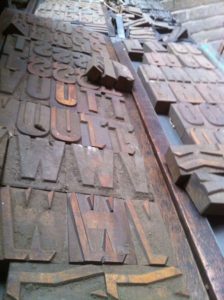Last week I had the pleasure of going back in to see John and Richard at Francis Cupiss. On arriving I was warmly greeted (as always) and told that since the launch of the new website they have been creating a catalogue of the letterpress type in the back room. As well as looking in the darkest crevices, they had started to explore other areas of the building not seen by man for, oh…. too long! John gingerly admitted that in the 44 years he had worked there he had not been in all the cupboards and didn’t know what may be hiding there.
In one box, hidden in the loft, above the washroom and mixed with another typeface was a wooden alphabet that they discovered had a duplicate ‘shadow’ set! (See the capital ‘W’s on the photo and also check out the years of dust!) How extraordinary!
How old is it?
The age of the font can’t be pinpointed exactly but it must have gone back to John’s great grandfather’s era or even earlier. Made from a box wood, a slow growing dense wood which came either from this country (as mentioned on CountryFile last Sunday – 1st June 2014) or could even have been imported from tropical Africa. Fonts from this era were originally hand carved around from the early to mid 1400’s, then much later they were produced more in abundance using routing machines and then eventually metal type came into being. This alphabet is hand carved as the chisel marks can clearly be seen and is distinctly different to machined wooden type. John suggests the wooden type may have come from the late 1800’s/early 1900’s from the company’s letterpress printing history.
One thing I was unaware of, is that wooden type of this era didn’t have font names as we know type by today, John mentioned that they wouldn’t have given specific names to any of the wooden type, only referred to them by depth (i.e. 6em).
We are all so excited that we are going to dust the type off, put this font back on the printing press and see how it would have looked in its hey day! Can’t wait.
